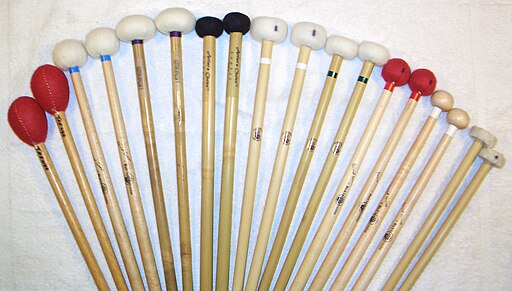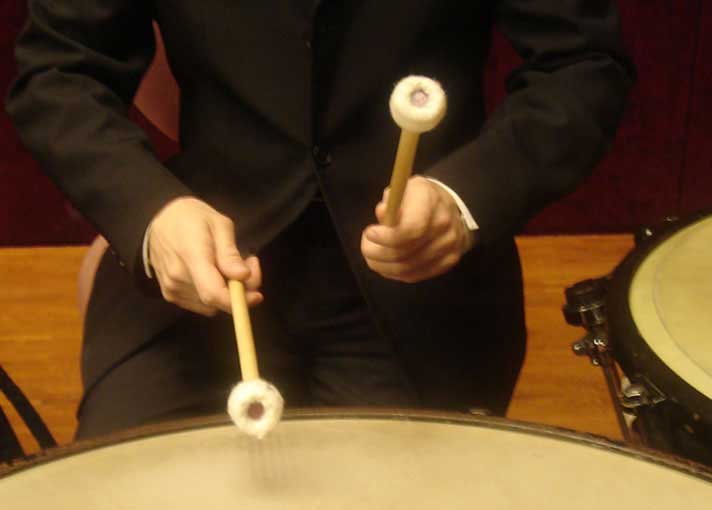Picture this, a hushed concert hall, the conductor’s baton poised in mid-air, and suddenly – BOOM! The timpani thunders to life, its resonant voice cutting through the silence. That, my fellow percussionists, is the power you hold at your fingertips.
But let’s face it, coaxing those magnificent kettledrums to sing isn’t just about whacking them aimlessly with a mallet and hoping for the best. It’s an art form, a delicate dance of physics and musicality that separates the amateurs from the maestros.
Whether you’re a greenhorn just starting to explore the world of orchestral percussion or a seasoned pro looking to fine-tune your skills, mastering essential timpani techniques is your ticket to percussion stardom.
These aren’t just party tricks to impress your section mates. They’re the fundamental building blocks that will elevate your playing from merely adequate to absolutely breathtaking.
In this guide, we’re diving headfirst into five game-changing timpani techniques. We’ll unravel the mysteries of the perfect mallet grip, demystify the dark arts of tuning, and even tackle the acrobatics of cross-drumming. By the time we’re done, you’ll be armed with the knowledge to make those timpani sing, whisper, and roar on command.
So, grab your favorite mallets and let’s embark on this rhythmic journey together. It’s time to transform those timpani from mere instruments into extensions of your musical soul. Ready to revolutionize your percussion game? Let’s roll!
- Technique 1: Mastering the Art of Mallet Grip and Stroke
- Technique 2: The Art of Tuning and Pitch Control
- Technique 3: Mastering the Art of Rolls
- Technique 4: The Art of Articulation and Dampening
- Technique 5: Mastering Cross-Drumming and Pedaling
- Advanced Techniques for the Aspiring Virtuoso
- Conclusion: Your Journey to Timpani Mastery
- Frequently Asked Questions (FAQ)
- Time To Take Your Timpani Skills to the Next Level
Technique 1: Mastering the Art of Mallet Grip and Stroke
When it comes to timpani techniques, your mallet grip is the foundation upon which all other skills are built. It’s not just about holding sticks, it’s about becoming one with your instruments.
The Great Grip Debate: French vs. German
In the world of timpani, two grip styles reign supreme, the French grip and the German grip. Each has its fervent supporters, but the truth is, both have their place in a timpanist’s toolkit.
French Grip: Imagine you’re holding a delicate teacup. This grip, with palms facing each other, offers unparalleled finger control and a lighter touch. It’s perfect for those whisper-soft passages that make audiences lean in.
German Grip: Now, picture yourself wielding a hammer. This grip, with palms facing down, provides more power and is ideal for those thunderous fortissimo moments that shake the concert hall.
The secret? Master both. Being able to seamlessly transition between grips will give you the versatility to tackle any score thrown your way.
Wrist Action: The Key to Tonal Variation
Your wrists are the unsung heroes of timpani playing. Developing wrist flexibility is crucial for achieving a wide range of tonal qualities. A relaxed wrist allows for better rebound control, resulting in cleaner articulation and more nuanced dynamics.
Pro Tip
Practice bouncing a tennis ball with your mallet. This simple exercise can work wonders for your wrist flexibility and stroke control.
Stroke Techniques: From Staccato to Legato
Different strokes for different folks? More like different strokes for different notes! Your stroke technique directly impacts the sound projection and tonal variation of your timpani.
• For sharp, staccato notes: Use a quick, snappy stroke with immediate rebound.
• For smooth, legato sounds: Employ a fluid motion, allowing the mallet to linger on the drumhead momentarily.
Remember, the interaction between your mallet and the drumhead is where the magic happens. Experiment with different stroke speeds and contact points to expand your tonal palette.
Mallet Selection: Choose Your Weapons Wisely
Just as a painter selects brushes, a timpanist must choose mallets carefully. Your mallet selection can dramatically alter your sound:
• Harder mallets: Produce brighter, more articulate tones. Perfect for cutting through in forte passages.
• Softer mallets: Offer warmer, rounder sounds. Ideal for blending with the orchestra in softer dynamics.

Image Source: Flamurai, via Wikimedia Commons
Investing in a diverse set of mallets will give you the tools to tackle any musical challenge with finesse.
Mastering your mallet grip and stroke technique is the first step towards timpani excellence. It’s not just about hitting the right notes, it’s about crafting each sound with intention and musicality.
So grab those mallets and start experimenting – your journey to becoming a timpani virtuoso starts here.
Technique 2: The Art of Tuning and Pitch Control
If mallet grip is the foundation of timpani playing, then tuning is its soul. Mastering pitch control can transform your kettledrums from mere rhythm makers to melodic powerhouses. Let’s dive into the world of timpani tuning, where physics meets music in perfect harmony.
Understanding Timpani Tuning Mechanisms
Modern timpani are marvels of acoustic engineering and most feature pedal mechanisms that allow for quick and precise pitch adjustments. But don’t be fooled. While these pedals make life easier, they’re not magic wands. Understanding the relationship between drumhead tension and pitch is crucial.
Key concept: As you increase the tension on the drumhead, the pitch rises. Decrease it, and the pitch lowers. Simple in theory, but it takes practice to nail those perfect intervals.
Developing Your Timpani Ear
Forget perfect pitch – what you need is a well-trained timpani ear. This isn’t just about recognizing notes, it’s about understanding the unique overtone series of timpani and how they interact with the orchestra.
Try this exercise: Play a note on the timpani, then sing it. Now adjust the pitch slightly and try to match it with your voice. This back-and-forth between playing and singing can dramatically improve your pitch accuracy.
Quick Tuning Techniques for Performance
In the heat of a performance, you won’t have time for lengthy tuning sessions. Here are some rapid-fire tuning tips:
1. Use clear pitch references: Keep a tuning fork or pitch pipe handy.
2. Learn to tune “on the fly”: Practice making small adjustments between notes without interrupting your playing.
3. Develop a mental map of your drums: Know which pitches are easily accessible on each drum.
Pro Tip
the tension rods with colorful tape. It’s a visual aid that can save you in a pinch.
The Challenge of Glissandi
Ah, the elusive timpani glissando, the stuff of percussionists’ dreams (and nightmares).
Mastering smooth pitch slides requires precise control of your pedal technique. Start slow, focusing on evenness of motion. As you improve, you’ll be sliding between pitches with the grace of a violinist.
Tuning in Different Acoustic Environments
Here’s a curveball. Your perfectly tuned timpani in the practice room might sound off in the concert hall. That’s because different acoustic properties can affect perceived pitch. Always take time to adjust to new spaces, and don’t be afraid to make last-minute tweaks.

Image Source: Lider Chang, via Wikimedia Commons
Remember, tuning isn’t just about getting the right pitch, it’s about blending with the ensemble and serving the music. A slightly sharp or flat note that fits the harmonic context is often preferable to a perfectly tuned note that stands out.
Mastering tuning and pitch control will elevate your timpani playing from good to extraordinary. It’s a lifelong journey of listening, adjusting, and refining. Embrace the challenge, and soon you’ll be navigating the world of pitch with confidence and musicality.
Technique 3: Mastering the Art of Rolls
Ah, the timpani roll. That thunderous rumble that can shake concert halls and send shivers down spines. But don’t be fooled, creating the perfect roll is more than just rapid-fire drumming.
It’s a delicate balance of speed, control, and musicality. Let’s dive into the world of timpani rolls and uncover the secrets to achieving that smooth, sustained sound that’s music to any conductor’s ears.
Single-Stroke vs. Double-Stroke Rolls: The Great Debate
In the world of percussion performance, the single-stroke and double-stroke roll techniques are like the yin and yang of timpani playing. Each has its place, and mastering both will make you a versatile timpanist.
Single-Stroke Rolls:
• Technique: Alternating hands in rapid succession (RLRLRL…)
• Pros: Great for faster tempos and shorter rolls
• Cons: Can be tiring for extended periods
Double-Stroke Rolls:
• Technique: Two hits per hand (RRLLRRLL…)
• Pros: More efficient for longer rolls, often produces a smoother sound
• Cons: Can be challenging to maintain evenness at high speeds
Pro Tip
Practice both techniques daily. Your go-to roll might depend on the piece, the tempo, or even the acoustic properties of the performance space.
Achieving That Buttery-Smooth Sustained Sound
The holy grail of timpani rolls is that perfectly smooth, sustained sound that seems to defy physics. Here’s how to get there:
1. Focus on consistency: Each stroke should be identical in force and speed.
2. Find your sweet spot: Experiment with different playing areas on the drumhead to find the optimal resonance.
3. Control your rebounds: Let the drum do some of the work for you. A well-tuned timpani will give you natural rebound.
Dynamics: From Whisper to Roar
A great timpanist can produce rolls at any dynamic level, from a barely-there pianissimo to a earth-shaking fortissimo. The key? It’s all in the wrist.
• For soft rolls: Use more finger control and less arm movement.
• For loud rolls: Engage more of your arm, but be careful not to tense up.
Remember, even in the loudest passages, your roll should never sound forced or strained.
Roll Speed: Matching the Music
The speed of your roll isn’t just about how fast you can move your hands. It’s about matching the musical context:
• In slow, lyrical passages a slower roll can create a sense of tension and anticipation.
• In fast, energetic sections a quicker roll adds excitement and drive.
Always listen to the overall orchestral texture and adjust your roll speed accordingly.
The Secret Ingredient: Mallet Choice
Your choice of mallets can make or break your roll technique. Softer mallets tend to produce smoother rolls but may lack articulation in louder dynamics. Harder mallets offer more clarity but can sound choppy in soft passages.
The solution? Have a variety of mallets at your disposal and don’t be afraid to switch mid-performance if needed.
Practicing Roll Techniques
Improving your roll technique isn’t just about mindless repetition. Try these focused exercises:
1. Roll Crescendos and Diminuendos. Practice smooth dynamic changes over long periods.
2. One-Handed Rolls. Strengthen each hand independently.
3. Roll-Rhythm Combinations. Alternate between rolls and specific rhythmic patterns.
Remember, the perfect roll is a combination of technical skill and musical sensitivity. It’s not just about creating noise – it’s about crafting a sound that enhances the overall orchestral experience.
Keep practicing, keep listening, and soon you’ll be rolling with the best of them!
Technique 4: The Art of Articulation and Dampening
In the world of timpani playing, it’s not just about what notes you play, but how you play them. Mastering articulation and dampening techniques is like adding a whole new vocabulary to your musical language.
Let’s dive into these crucial skills that can transform your timpani performance from good to extraordinary.
Staccato vs. Legato: Shaping Your Sound
Articulation in timpani playing is all about controlling the length and character of each note. It’s the difference between a sharp, punchy sound and a smooth, flowing one.
Staccato Playing:
• Technique: Quick, crisp strokes with immediate dampening
• Effect: Short, detached notes that cut through the orchestral texture
• Best for: Rhythmic passages, martial themes, or adding punctuation to the music
Legato Playing:
• Technique: Smooth, connected strokes with minimal dampening
• Effect: Long, sustained notes that blend with the ensemble
• Best for: Lyrical melodies, creating a sense of flow or continuity
Pro Tip
Practice transitioning between staccato and legato playing. The ability to switch seamlessly between articulations is a hallmark of a skilled timpanist.
The Subtle Art of Dampening
Dampening is the unsung hero of timpani techniques. But, it’s not just about stopping the sound, it’s about shaping it.
Types of Dampening:
1. Hand dampening: Using your hand to mute the drumhead
2. Mallet dampening: Using the mallet head to control resonance
3. Pedal dampening: Slightly releasing pedal tension to shorten note length
Each method has its place, and mastering all three will give you ultimate control over your sound projection and tonal variation.
Creating Different Articulations with Mallet Choice
Your choice of mallets can dramatically affect your articulation:
• Harder mallets: Produce clearer articulation, great for staccato playing
• Softer mallets: Offer smoother articulation, ideal for legato passages
• Specialty mallets: Can create unique articulations (e.g., brush mallets for a softer attack)
Experiment with different mallet types to expand your articulation palette.
The Role of Dynamics in Articulation
Articulation isn’t just about note length, it’s also about how you use dynamics to shape each note:
• For sharp accents: Use a quick stroke with a sudden increase in volume
• For gentle phrasing: Employ subtle dynamic changes within each note
Remember, great articulation is about nuance. Even small changes in how you approach each note can make a big difference in the overall musical phrasing.

Image Source: Villwock, via Wikimedia Commons
Dampening in Different Acoustic Environments
The acoustic properties of your performance space can greatly affect how you approach dampening:
• In reverberant halls: You might need to dampen more aggressively to maintain clarity
• In dry acoustics: Less dampening might be necessary to achieve a full sound
Always take time to adjust your dampening techniques to the specific acoustic environment you’re playing in.
Practicing Articulation and Dampening
Here are some exercises to refine your articulation and dampening skills:
1. Articulation scales: Play scales using different articulations (staccato, legato, accented)
2. Dampening drills: Practice quick, clean dampening after playing various rhythms
3. Articulation etudes: Work on pieces that require frequent changes in articulation
Remember, the goal of articulation and dampening is to serve the music. These techniques should enhance your musical expression, not overshadow it. With practice, you’ll develop the control and sensitivity to shape each note precisely as the music demands.
Technique 5: Mastering Cross-Drumming and Pedaling
Now it’s time to get into the acrobatics of timpani playing. Cross-drumming and pedaling are where your skills truly take flight, transforming you from a mere drummer into a percussion virtuoso.
These techniques require a perfect blend of physical coordination, musical timing, and spatial awareness. So let’s dive into the exciting world of multi-drum mastery.
The Art of Efficient Movement
Cross-drumming is all about navigating your timpani setup with grace and precision. It’s like a well-choreographed dance routine, but instead of a dance floor, you’re working with a semicircle of kettledrums.
Key principles for effective cross-drumming:
1. Economy of motion: Every movement should be purposeful and efficient
2. Anticipation: Always think two steps ahead in the music
3. Body positioning: Find the sweet spot that gives you access to all drums
Pro Tip
Practice your cross-drumming patterns without mallets first. This helps you focus on the movement itself without worrying about striking the drums.
Pedal Technique: The Hidden Virtuosity
While your hands are busy creating rhythms, your feet are quietly working magic with the pedals. Mastering pedal technique is crucial for smooth pitch changes and seamless transitions between drums.
Pedal techniques to master:
• Heel-toe technique: For subtle, precise pitch adjustments
• Sliding technique: For quick glissandi or rapid pitch changes
• Pedal dampening: Using the pedal to control note length and resonance
Remember, your pedal work should be as musical as your mallet technique. Practice pedaling with the same attention to detail you give to your hand movements.
Coordinating Hands and Feet: The Ultimate Challenge
The real test of a timpanist’s skill is the ability to coordinate complex hand patterns with simultaneous pedal movements. This is where you truly become a one-person percussion ensemble.
Tips for improving hand-foot coordination:
1. Start slow: Begin with simple patterns and gradually increase complexity
2. Use a metronome: Ensure your timing remains steady as you add layers of movement
3. Practice in sections: Break down difficult passages into smaller, manageable chunks
Ensemble Playing: Blending with the Orchestra
In orchestral settings, your cross-drumming and pedaling skills need to serve the bigger picture. It’s not just about executing complex patterns, it’s about how those patterns fit into the overall musical texture.
Consider these factors:
• Balance: Adjust your playing to blend with different orchestral sections
• Timing: Sync your movements with the conductor and other musicians
• Adaptability: Be ready to adjust your technique based on the acoustics of the performance space
Advanced Techniques for the Aspiring Virtuoso
Ready to take your timpani skills to the next level? Here are some advanced techniques to explore:
• One-handed rolls while cross-drumming
• Simultaneous pitch bending on multiple drums
• Incorporating auxiliary percussion into your timpani setup
Remember, these advanced techniques should enhance the music, not overshadow it. Use them judiciously to add color and excitement to your performances.
Practice Makes Perfect
Developing your cross-drumming and pedaling skills takes time and patience. Here are some practice strategies:
1. Isolated practice: Work on hand and foot movements separately before combining them
2. Slow-motion practice: Perform difficult passages at a fraction of the tempo to perfect your movements
3. Record yourself: Video your practice sessions to analyze and improve your technique
As you master these techniques, you’ll find a new world of musical expression opening up before you. Cross-drumming and pedaling aren’t just technical skills, they’re tools that allow you to bring the composer’s vision to life with flair and precision.
So grab your mallets, position those pedals, and get ready to dance across your timpani like the percussion maestro you are. With practice and perseverance, you’ll soon be weaving complex rhythms and melodies across your drums with the ease of a true virtuoso.
Conclusion: Your Journey to Timpani Mastery
Congratulations, intrepid percussionist! You’ve just embarked on an exhilarating journey through the world of advanced timpani techniques. From the nuanced art of mallet grip to the acrobatics of cross-drumming, you’ve gained insights that will elevate your orchestral percussion game to new heights.
Let’s recap the five essential timpani techniques we’ve explored:
1. Mallet Grip and Stroke: The foundation of your timpani sound
2. Tuning and Pitch Control: Transforming your kettledrums into melodic powerhouses
3. Roll Techniques: Creating that smooth, sustained thunder
4. Articulation and Dampening: Shaping each note with precision
5. Cross-Drumming and Pedaling: Becoming a one-person percussion ensemble
Remember, mastering these techniques isn’t just about technical proficiency, it’s about enhancing your musical expression and contributing to the rich tapestry of orchestral sound.
As you practice, always keep the bigger picture in mind. How does your playing serve the music? And, how can you best support your fellow musicians in the ensemble?
The Path Forward: Continuous Improvement
Your journey doesn’t end here. The world of timpani performance is ever-evolving, with new compositions pushing the boundaries of what’s possible on these magnificent instruments. Stay curious, keep experimenting, and never stop refining your craft.
Here are some ways to continue your timpani education:
• Attend workshops and masterclasses with renowned percussionists
• Explore contemporary repertoire that challenges traditional timpani techniques
• Collaborate with composers to develop new ways of playing the instrument
• Record your practice sessions and performances for self-analysis
Remember, even the most accomplished timpanists never stop learning. Embrace the challenges, celebrate the breakthroughs, and enjoy the lifelong journey of musical growth.
Embrace Your Percussive Potential
Now that you’re armed with these essential timpani techniques, it’s time to put them into practice. Here’s what you can do right now to take your playing to the next level:
1. Set up a practice routine that incorporates all five techniques
2. Choose a challenging piece of music and apply these new skills
3. Record yourself playing and analyze your performance
4. Share your progress with fellow percussionists and seek feedback
5. Explore opportunities to perform in ensembles and apply your new techniques in a group setting
Remember, every great timpanist started at the beginning. With dedication, practice, and a passion for percussion, you have the potential to become a true master of the kettledrums.
So grab those mallets, approach your timpani with confidence, and let your newfound skills resonate through the concert hall. The world is waiting to hear the thunder you can create!
Frequently Asked Questions (FAQ)
To help you on your timpani journey, I’ve compiled the answers to some of the most common questions about timpani techniques and orchestral percussion. And for even more information about the timpani, read The Ultimate Timpani Guide | 27 Fascinating Instrument Questions Answered.
Remember, mastering timpani techniques is a lifelong journey. Keep exploring, keep practicing, and most importantly, keep making music! Your dedication to honing these skills will not only make you a better timpanist but a more well-rounded musician overall.
Time To Take Your Timpani Skills to the Next Level
Congratulations! You’ve just explored the essential techniques that form the backbone of exceptional timpani playing. But remember, knowledge is just the first step – now it’s time to put these skills into practice and truly elevate your orchestral percussion game.
Here’s how you can take action and continue your timpani journey:
1. Practice, Practice, Practice
Set aside dedicated time each day to work on these techniques. Remember, consistency is key. Even 15 minutes of focused practice can make a significant difference over time.
2. Record and Analyze
Use your smartphone or a digital recorder to capture your practice sessions. Listen back critically, paying attention to your tone, timing, and technique. This self-analysis is invaluable for improvement.
3. Seek Feedback
Don’t practice in a vacuum. Share your progress with teachers, fellow percussionists, or even online communities. Fresh ears can often catch things we miss ourselves.
4. Expand Your Repertoire
Challenge yourself with new pieces that push your technical and musical boundaries. Explore works from different eras and styles to broaden your timpani horizons.
5. Invest in Your Tools
Consider upgrading your mallets or even your practice pad. Quality tools can make a significant difference in your sound and technique development.
6. Attend Masterclasses and Workshops
Look for opportunities to learn from professional timpanists. Many offer online classes if in-person events aren’t available in your area.
7. Join an Ensemble
Nothing beats real-world experience. Look for community orchestras, percussion ensembles, or even start your own group to apply your skills in a collaborative setting.
8. Stay Curious
The world of percussion is always evolving. Stay up-to-date with new techniques, compositions, and technological advancements in the field.
Remember, becoming a master timpanist is a lifelong journey. Embrace the challenges, celebrate the victories (no matter how small), and always keep your passion for music at the forefront.
I’d love to hear about your timpani journey. So, share your experiences, questions, or tips in the comments below.
And if you found this guide helpful, don’t forget to share it with your fellow percussionists.
Now, grab those mallets and start making some thunder! Your audience awaits, and the orchestra’s beating heart is in your capable hands.


